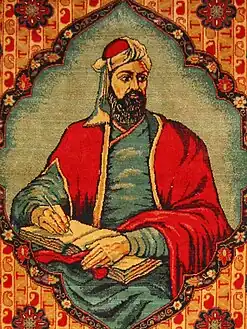خسرو وشيرين
خسرو وشيرين هو عنوان قصة رومانسية مأساوية شهيرة للشاعر الفارسي نظامي الكنجوي (1141-1209)، الذي كتب أيضًا روايةليلى والمجنون. وهو يروي نسخة خيالية متقنة للغاية لقصة حب الملك الساساني كسرى الثاني للأميرة الأرمنية شيرين، التي أصبحت ملكة بلاد فارس.[1][2][3][4] وهي قصة مشهورة في أدب أذربيجاني[5] و الفارسي والتركي .[6] ذكرها الفردوسي في الشاهنامة ثم نظمها الشاعر أذربيجاني نظامي الكنجوي[7] وخسرو الدهلوي ونظمها بالتركية شيخي وعطائي وأهي.
| جزء من من سلسلة مقالات حول |
| نظامي الكنجوي |
|---|
 |
| الكنوز الخمسة |
|
| مواضيع ذات صلة |
|
| معالم ونصب تذكاريّة |
|
|
السرد الأساسي هو قصة حب من أصل فارسي كانت معروفة بالفعل من القصيدة الملحمية التاريخية العظيمة الشاهنامه وغيره من الكتاب الفارسيين والحكايات الشعبية ، وأعمال أخرى تحمل نفس العنوان. كما رويت أشكال مختلفة من القصة تحت عناوين «شيرين وفرهاد» (بالفارسية: شیرین و فرهاد).[8]
المؤلف
شرع نظامي في نظم قصة خسرو وشیرین بعد فراغه من نظم مخزن الأسرار وهي تقع فی 6500 بیت من الشعر تقریباً. نظمها الشاعر في بحر الهزج المسدس وفرغ من نظمها في عام 585 من الهجرة. وقدم الشاعر هذه المنظومة للأتابك جهان بهلوان ثم قدمها لأخيه قزل أرسلان من بعده.

موضوع القصة
تتحدث القصة عن مغامرات الملك الساساني كسرى الثاني بن هرمز وغرامه مع معشوقته الجميلة شيرين ونهایة منافسه التعیس فرهاد. أما باقي القصة فيدور حول زواج الملك من شيرين ثم حب شيرويه ابن الملك لها، وقتل هذا الأبن أباه، ورغب في الزواج من شيرين. فذهبت إلى ناووس الملك القتيل وشربت السم، فماتت بجواره.
أستطاع نظامي أن یخرج لنا قصة غرامية علی عکس الفردوسي الذی أخرجها قصة حماسية من خلال الشاهنامة.
مراجع
- The الموسوعة الإيرانية ("Ḵosrow o Širin" Encyclopædia Iranica, Paola Orsatti)"Two traditions soon formed around the figure of Širin: one in her favor, with its roots in Armenia and in the Christian regions of the Caucasus, where, as we have seen, Neẓāmi found his source; and the second, represented in the Šāh-nāma, where Širin is shown as a woman of humble origin and ill repute, who makes merciless use of poison (in Ferdowsi, Širin, wrought with jealousy, poisons Maryam)." نسخة محفوظة 17 نوفمبر 2020 على موقع واي باك مشين.
- The الموسوعة الإيرانية ("Farhad" Encyclopædia Iranica, Heshmat Moayyad) نسخة محفوظة 8 نوفمبر 2020 على موقع واي باك مشين.
- The Khuzistan Chronicle, written by a Syriac Christian from Khuzistan (Beth Huzaye in Aramaic/Syriac) [Iran], probably in 680, is described as the Syriac counterpart of the Armenian work of Sebeos. We read about the relationship between the bishop Isho Yahb and the Persian king Khosrau II Parvez (590–628): "Isho Yahb was treated respectfully throughout his life, by the king himself and his two Christian wives Shirin the Aramean and Mary the Roman". (Theodor. Nöldeke: Die von Guidi herausgegebene syrische Chronik, Wien 1893, p. 10.) The Chronicle of Séert (Siirt) is an anonymously authored historiographical text written by the Nestorian Church in Persia and the Middle East, possibly as early as the 9th century AD. The text deals with ecclesiastical, social, and political issues of the Christian church giving a history of its leaders and notable members. LVIII. – History of Khosrau Parvez, son of Hormizd "Khosrau, by gratitude for Maurice, ordered to rebuild churches and to honor the Christians. He built himself two churches for Marie (Maryam) and a large church and a castle in the country of Beth Lashpar for his wife Shirin, the Aramean." (Patrologia Orientalis, Tome VII. – Fascicule 2, Histoire Nestorienne (Chronique de Séert), Seconde Partie (1), publiée et traduite par Mgr Addai Scher, Paris 1911, Published Paris : Firmin-Didot 1950 p. 467.)
- Johan Christoph Burgel & Christine van Ruyuymbeke, "Nizami: A Key to the Treasure of the Hakim ", Amsterdam University Press, 2011. pg 145: "Shirin is presented as an Armenian princess
- The second the romantic epic Khosrow o-Shirin of Nizami Gnajavi- Copyright (c) 1996-2006 Encyclopedia Britannica Online نسخة محفوظة 4 فبراير 2012 على موقع واي باك مشين.
- "معلومات عن خسرو وشيرين على موقع britannica.com". britannica.com. مؤرشف من الأصل في 2015-09-21.
- Neẓāmī, in full Elyās Yūsof Neẓāmī Ganjavī, Neẓāmī also spelled Niẓāmī, (born c. 1141, Ganja, Seljuq empire [now Ganca, Azerbaijan] نسخة محفوظة 19 أكتوبر 2018 على موقع واي باك مشين.
- Alexander the Great in the Persian Tradition. I.B.Tauris. 2018. ISBN:978-1-78673-366-5. مؤرشف من الأصل في 2021-02-16.
- بوابة أدب
- بوابة أذربيجان
- بوابة كتب